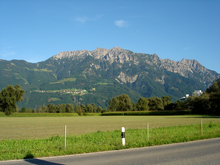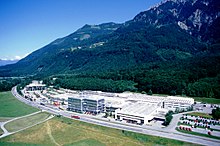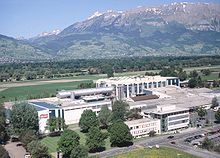Liechtenstein's economy
| Liechtenstein | |
|---|---|

|
|
| World economic rank | 143. |
| currency | Swiss Francs (CHF) |
| Conversion rate | 1 CHF = 0.93245 EUR (March 14, 2017) |
| Trade organizations |
EEA , EFTA , WTO |
| Key figures | |
|
Gross domestic product (GDP) |
$ 4.603 billion (nominal) (2007) $ 4.16 billion (PPP) (2007) |
| GDP per capita | $ 134,400 (nominal) (2007) $ 122,100 (PPP) (2007) |
| GDP by economic sector |
Agriculture : 0.8% (2009) Industry : 41.3% (2009) Services : 57.9% (2009) |
| growth | 9.6% (2010) |
| inflation rate | 2.4% (2008) |
| Employed | 18,000 (2008) |
| Employed persons by economic sector |
Agriculture : 1.7% (2006) Industry : 43.5% (2006) Services : 55.4% (2006) |
| Activity rate | 50.3% (2008) |
| Unemployed | 461 (December 2014) |
| Unemployment rate | 2.4% (December 2014) |
| Foreign trade | |
| export | approx. € 2.3 billion (2009) |
| Export goods | Machines, metal (products), vehicles |
| Export partner |
Germany : 22% (2010) USA : 12.8% (2010) Austria : 11.7% (2010) |
| import | approx. € 1.4 billion (2009) |
| Import goods | Machines, metal (products), chemical products |
| Import partner |
Germany : 39.8% (2010) Austria : 34.7% (2010) Italy : 3.6% (2010) |
| public finances | |
| Government revenue | 20.8% of GDP (2008) |
| Government spending | 23.2% of GDP (2008) |
| Budget balance | 2.4% of GDP (2008) |
The economy of the Principality of Liechtenstein is mainly focused on the secondary ( industry ) and tertiary ( service ) economic sectors.
With a gross domestic product (GDP) of 5.3 billion Swiss francs, Liechtenstein ranks 143rd on the list of countries by GDP . In terms of GDP per capita, Liechtenstein ranks first with around 130,000 Swiss francs. Due to the large proportion of commuters in the total number of people employed in Liechtenstein, however, it is difficult to draw any conclusions from the gross domestic product about the income situation of the population. And so in 2010 more than 50% of the 34,334 employees in Liechtenstein were not resident in Liechtenstein, but commuted from abroad. This fact means that Liechtenstein is also seen as an economic engine for the wider region.
In addition, Liechtenstein is one of the most industrialized countries in the world - over 40% of the workforce and around 40% of the gross domestic product can be assigned to this branch of industry.
history
Start of industrialization
The start of industrialization in Liechtenstein came relatively late: not until the second half of the 19th century. This late modernization can mainly be explained by the isolation of the country until 1852 - because until that year Liechtenstein was almost completely on its own and had a hard time entering into trade agreements with its neighbors. However, the situation changed with the customs treaty with Austria-Hungary of 1852, which enabled Liechtenstein to be incorporated into the economy of the dual monarchy.
The new traffic structures that had been created since 1858 were also of great importance for the development process of Liechtenstein: In this and the following years a railway line from Rorschach to Chur and the Rhine bridges between Schaan and Bendern were built. And so new companies emerged in the next few years, especially in the textile industry .
Customs treaty with Switzerland and other developments
But during the First World War , the Allies banned the supply of yarn via Switzerland - although Liechtenstein remained neutral, as in World War II - so that the textile industry came to a complete standstill. Associated with this was the impoverishment of the Liechtenstein population. At the end of the war, Liechtenstein finally dissolved the customs treaty with the loser Austria-Hungary .
After the dissolution of the customs treaty with Austria in 1919, Liechtenstein increasingly came closer to Switzerland and finally in 1923 the customs treaty with Switzerland, which still exists today, was signed.
Liechtenstein remained neutral during World War II and was never directly involved in acts of war. Instead, the principality was able to use its locational advantages and so many new industrial companies were founded in Liechtenstein and strong economic growth began.
In 1995, the company joined the European Economic Area (EEA) , which led to a renewed economic upswing in Liechtenstein - which has continued to this day.
Economic structure
Agriculture and Forestry
As of December 31, 2013, 275 people were employed in the “Agriculture, forestry, fishing” sector in Liechtenstein - which corresponds to 0.8 percent of the total workforce.
In 2013 there were 109 recognized agricultural holdings in Liechtenstein that cultivated 3,567 hectares of agricultural land, which corresponds to an average farm size of 32.7 hectares. 24 of the companies were active in the mountain zone . 30.3 percent of the farms with a total area of 1,088 hectares produced according to the guidelines of organic farming. 60 percent of the agricultural area was cultivated as permanent grassland , the remaining areas as arable land and special crops . Most of the farms have specialized in animal husbandry and so in 2013 6,010 head of cattle were produced in Liechtenstein , including 2,363 dairy cows, 300 horses , 3,522 sheep , 269 goats , 1,655 pigs and approx '811 farm chickens kept.
Liechtenstein has a forest area of 6,865 hectares with an average wood supply of 409 solid cubic meters per hectare. Around 25,000 solid cubic meters of wood are used in Liechtenstein's forests every year .
Industry
Due to the fact that over 40% of the workforce and around 40% of the gross domestic product is generated in the second economic sector, Liechtenstein is one of the most heavily industrialized countries in the world. A total of 14,036 employees were employed in the industry in 2010, which were distributed across a total of 588 workplaces.
Foreign trade
Because of the small domestic market in Liechtenstein itself, the industry is heavily dependent on exports abroad. In 2011, a total of 272,274 tons of goods valued at around CHF 3,32 billion were exported. The export of goods to Switzerland is not included due to the customs union. With around 24% of total exports, most goods (in terms of value) were exported to Germany in 2011 (approx. 803 million CHF). The other most important goods buyers were the USA (approx. 380 million CHF), Austria (approx. 360 million CHF), and France (approx. 286 million CHF). At over 27%, the export of goods to the People's Republic of China increased particularly strongly in 2011, so that China is already the 5th most important buyer of Liechtenstein products.
In contrast, goods worth around CHF 1.9 billion were imported in 2011 (excluding Switzerland). Most of the goods were imported from Austria and Germany with around CHF 730 million each.
Companies
In mechanical engineering , most employees work with nearly 3,000 employees. Followed by the construction industry and the food industry . The ThyssenKrupp Presta AG , headquartered in Eschen provides with around 2,500 employees in Liechtenstein, the largest company in the Principality, and is the world's market leader for steering columns in cars. Probably the best-known company that has its roots in Liechtenstein is the tool manufacturer Hilti AG . The company employs over 20,000 people worldwide - around 1,900 of them in Liechtenstein. The Hilcona AG and the Ospelt Group are the two major food manufacturers in Liechtenstein with about 780 or 900 employees. The Ivoclar Vivadent AG is one of the world's leading, in dentistry working, company. The largest industrial company from Vaduz is Hoval AG , which, among other things, produces heating equipment in the Liechtenstein capital. The OC Oerlikon Balzers also counts with around 650 employees of the largest companies in Liechtenstein and operates from Balzers of their business with thin film coatings. In addition, Swarovski AG also has one of its main branches in Liechtenstein with around 670 employees.
There are also numerous other industrial companies that are often among the market leaders in their business areas.
Services
In 2010, the service sector represented the largest economic sector with a share of around 58% of the total number of employees. However, tertiaryisation in Liechtenstein is not as advanced as, for example, in neighboring countries.
Financial services

Around 17 percent of Liechtenstein jobs are in the financial sector, which - contrary to popular belief - only represents a smaller area of the economy. The largest banks in the Principality are the LGT Bank , the Liechtensteinische Landesbank and the Verwaltungs- und Privatbank . The Principality issues banking licenses for the operation of banks . In addition to the three large banks, other financial institutions have also been approved since 1992. These also included foreign banks, whose admission was made possible by Liechtenstein's accession to the European Economic Area .
Tax conflicts
Liechtenstein has one of the strictest banking secrets in the world. In 2008 there was a tax affair with Germany , in which numerous German tax evaders were exposed who Liechtenstein foundations had made possible their fraud. The currency partner Switzerland also wanted to follow an EU initiative to disclose data from banks to the tax authorities by 2018, but Liechtenstein initially did not comment. In December 2011, Prime Minister Klaus Tschütscher announced in an interview that he wanted to regulate tax issues in connection with German investments in Liechtenstein with Germany. However, so far neither agreements nor negotiations have been announced.
On January 28, 2016, the EU Commission presented a package of measures to combat tax evasion , including Liechtenstein on the black list of tax havens .
tourism

Compared to the other economic sectors, tourism is only of minor importance. Nevertheless, in 2011 Liechtenstein recorded over 72,800 guest arrivals and over 167,000 overnight stays (not including day visitors). The most important holiday resort is Malbun , which attracts numerous guests both in winter and in summer. A general distinction is made in Liechtenstein between tourism in the Alpine region and that in the Rhine Valley . While the former focuses on sporting activities (e.g. hiking), cultural and business tourism are particularly important in the valley .
Web links
- Fabian Frommelt, Ulrike Mayr, Christoph Maria Merki: Economy. In: Historical Lexicon of the Principality of Liechtenstein .
Individual evidence
- ↑ a b c d e f g CIA World Factbook - Field listing GDP Retrieved October 13, 2010
- ↑ Exchange rates of the Swiss franc. Accessed March 14, 2017
- ↑ Foreign Office - Liechtenstein's Economy Retrieved on March 21, 2011
- ↑ Liechtenstein Statistics Office - PDF National Accounts ( Memento of November 29, 2011 in the Internet Archive ) Retrieved on October 13, 2010
- ↑ Archive link ( Memento from July 15, 2012 in the Internet Archive ) Retrieved on February 27, 2012
- ^ Office for Statistics Liechtenstein - PDF Economics ( Memento of December 3, 2010 in the Internet Archive ) Retrieved on October 13, 2010
- ^ Eurostat - Employment. Accessed 13 October 2010
- ↑ Liechtenstein Statistics Office. Accessed on April 27, 2015
- ↑ Liechtenstein Statistics Office. Accessed on April 27, 2015
- ^ Office for Statistics Liechtenstein - Foreign Trade, PDF Quarterly Results Export 2009 ( Memento of November 29, 2011 in the Internet Archive ) all data excluding Switzerland; Retrieved October 13, 2010
- ↑ a b Liechtenstein Statistics Office - PDF Foreign Trade 2010 ( Memento of November 29, 2011 in the Internet Archive ) Retrieved on October 13, 2010
- ^ Office for Statistics Liechtenstein - Foreign Trade, PDF Quarterly Results Export 2010 ( Memento of November 29, 2011 in the Internet Archive ) all data excluding Switzerland; Retrieved October 13, 2010
- ^ Office for Statistics Liechtenstein - Foreign Trade, PDF Quarterly Results Import 2009 ( Memento of November 29, 2011 in the Internet Archive ) all data excluding Switzerland; Retrieved October 13, 2010
- ^ Office for Statistics Liechtenstein - Foreign Trade, PDF Quarterly Results Import 2010 ( Memento of November 29, 2011 in the Internet Archive ) all data excluding Switzerland; Retrieved October 13, 2010
- ↑ a b c Liechtenstein Statistics Office - PDF Public Finances ( Memento of December 2, 2010 in the Internet Archive ) Retrieved on October 13, 2010
- ↑ Liechtenstein Statistics Office - National Economic Accounts 2008 ( Memento of July 15, 2012 in the Internet Archive ), accessed on October 16, 2010
- ↑ Employees in Liechtenstein ( Memento of November 2, 2013 in the Internet Archive ) Statistical Office - Retrieved on July 18, 2012.
- ↑ Industry in international comparison
- ↑ Alois Vogt: The Principality of Liechtenstein and its economic development 1952, p. 45.
- ^ Paul Vogt: Bridges to the Past. 1990, p. 176.
- ^ Pierre Raton: Liechtenstein State and History. 1969, pp. 74-78.
- ^ Pierre Raton: Liechtenstein State and History. 1969, pp. 139-145.
- ↑ EEA a huge success story . Neue Zürcher Zeitung, May 13, 2012. Retrieved July 18, 2012.
- ^ Office for Statistics of the Principality of Liechtenstein: "Statistisches Jahrbuch Liechtensteins 2015", p. 133 . Retrieved October 22, 2015.
- ^ Office for Statistics of the Principality of Liechtenstein: "Agricultural Statistics 2013" . Retrieved October 22, 2015.
- ^ Office for Forests, Nature and Landscape of the Principality of Liechtenstein: Landeswaldinventar 2012 . Retrieved October 22, 2015.
- ↑ Industry in international comparison
- ↑ workplaces and employees; P. 12 ( Memento of November 2, 2013 in the Internet Archive ) Statistical Office - Retrieved July 18, 2012.
- ↑ Foreign trade: direct exports of goods ( Memento from July 15, 2012 in the Internet Archive ) Statistical Office - accessed on July 18, 2012.
- ↑ Foreign trade: direct imports of goods ( Memento from November 14, 2012 in the Internet Archive ) Statistical Office - Retrieved on July 18, 2012.
- ↑ workplaces and employees; P. 22 ( Memento of November 2, 2013 in the Internet Archive ) Statistical Office - Retrieved July 18, 2012.
- ↑ Liechtenstein as an industrial location; P. 20 ( Memento of May 17, 2012 in the Internet Archive ) Retrieved July 18, 2012.
- ↑ Liechtenstein as an industrial location; P. 15 ( Memento of May 17, 2012 in the Internet Archive ) Retrieved July 18, 2012.
- ↑ Liechtenstein as an industrial location; P. 16, 22 ( Memento of May 17, 2012 in the Internet Archive ) Retrieved July 18, 2012.
- ↑ Liechtenstein as an industrial location; P. 16, 19 ( Memento from May 17, 2012 in the Internet Archive )
- ↑ Liechtenstein as an industrial location; P. 18 ( Memento from May 17, 2012 in the Internet Archive )
- ↑ Liechtenstein as an industrial location; P. 21 ( Memento of May 17, 2012 in the Internet Archive )
- ↑ workplaces and employees; P. 9 ( Memento of November 2, 2013 in the Internet Archive ) Statistical Office - Retrieved July 18, 2012.
- ↑ Finanzplatz ( Memento from May 17, 2012 in the Internet Archive ) Liechtenstein Government - Retrieved on May 1, 2011.
- ↑ Alexander Meili, History of the Banking System in Liechtenstein (1945-1980). Studies on Contemporary History, Vol. 1 ( Memento from February 28, 2016 in the Internet Archive ), ed. Urs Altermatt , Verlag Huber, 2001, especially chapter State intervention to protect the financial sector, p. 61ff.
- ↑ White money strategy . Neue Zürcher Zeitung, December 20, 2010. Retrieved April 25, 2011.
- ↑ Liechtenstein wants to get rid of German black money . Welt Online, December 4, 2011. Retrieved July 18, 2012.
- ↑ Trend: EU wants new black list of tax havens
- ↑ tourism; P. 8 ( Memento of June 24, 2012 in the Internet Archive ) Statistical Office - Retrieved July 18, 2012.



